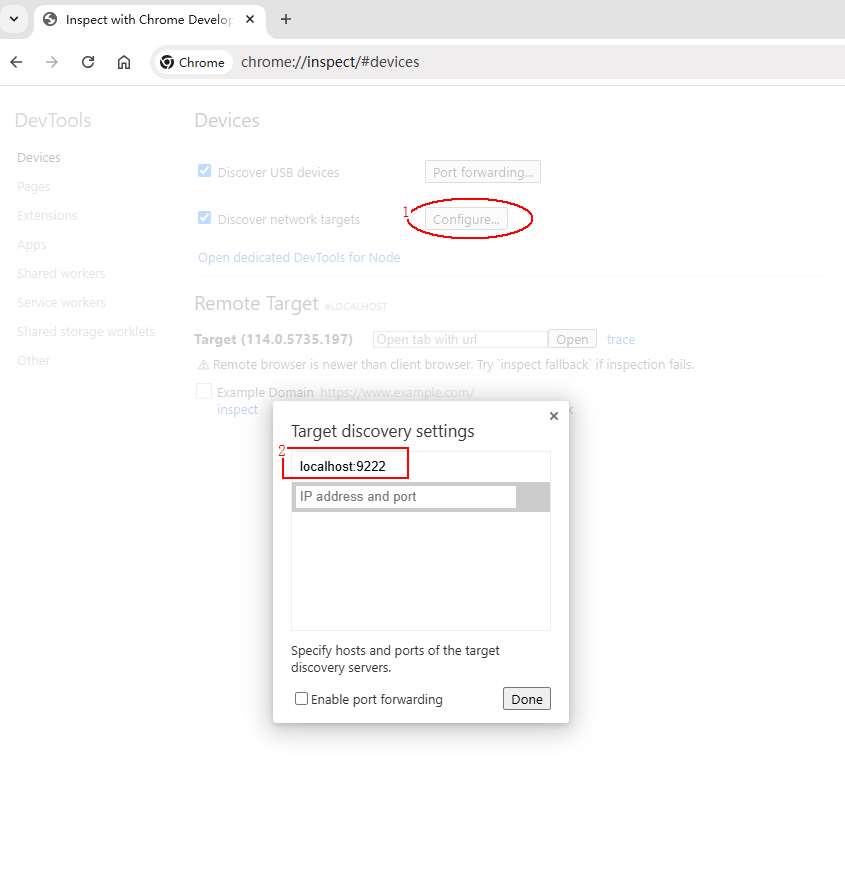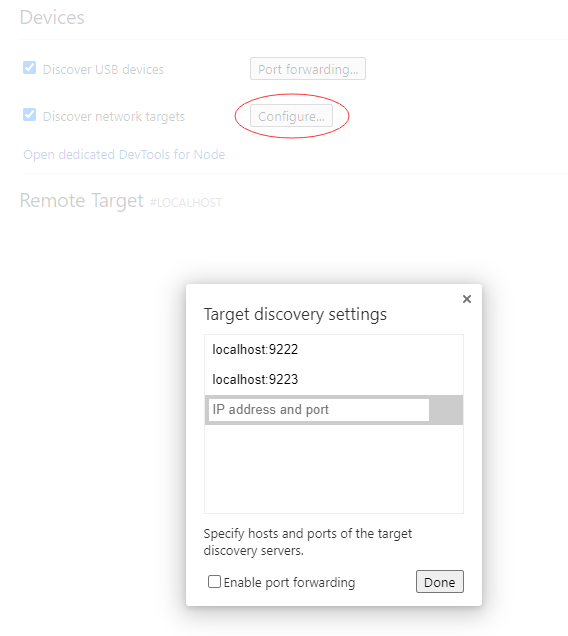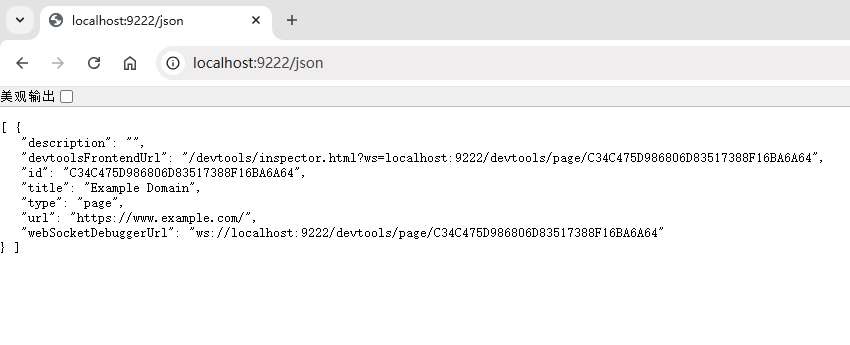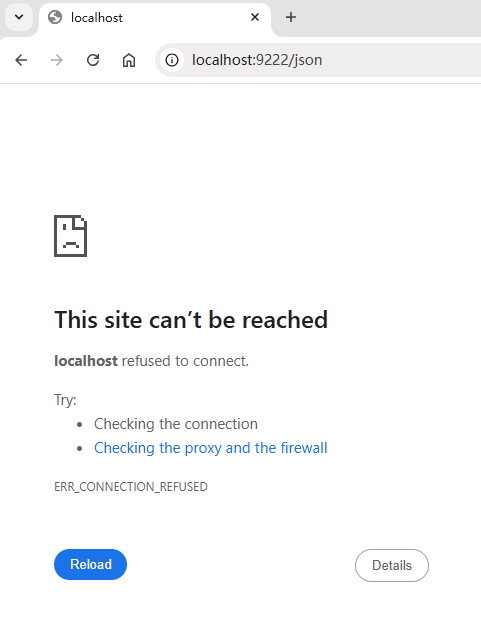harmony 鸿蒙Debugging Frontend Pages by Using DevTools
Debugging Frontend Pages by Using DevTools
The Web component supports debugging of web frontend pages by using DevTools, a web frontend development and debugging tool that allows you to debug an application’s frontend pages on a PC. Before you do this, use setWebDebuggingAccess() to enable frontend page debugging for the Web component and make sure the test device connected to the PC runs 4.1.0 or a later version.
Procedure
Enabling Web Debugging for Application Code
Before debugging a web page, call the setWebDebuggingAccess() API to enable the web debugging function. If the web debugging function is not enabled, DevTools cannot detect the web page to be debugged.
- Enable web frontend page debugging in the application code.
// xxx.ets
import { webview } from '@kit.ArkWeb';
@Entry
@Component
struct WebComponent {
controller: webview.WebviewController = new webview.WebviewController();
aboutToAppear() {
// Enable web frontend page debugging.
webview.WebviewController.setWebDebuggingAccess(true);
}
build() {
Column() {
Web({ src: 'www.example.com', controller: this.controller })
}
}
}
- Declare the required permission in the module.json5 file of the HAP module in the application project in DevEco Studio. For details, see Declaring Permissions in the Configuration File.
"requestPermissions":[
{
"name" : "ohos.permission.INTERNET"
}
]
Connecting the Device to a PC
Connect the device to a PC and enable Developer mode for subsequent port forwarding operations.
- Enable Developer mode and USB debugging on your device.
(1) Choose Settings > System and check whether Developer options is available. If not, go to Settings > About and touch the version number for seven consecutive times until the message “Enable developer mode?” is displayed. Touch OK and enter the PIN (if set). Then the device will automatically restart.
(2) Connect the device to the PC using a USB cable. Choose Settings > System > Developer options and enable USB debugging. In the displayed dialog box, touch Allow.
Run the hdc command to connect to the device. Run the following command in the CLI to check whether hdc can discover the device.
hdc list targets- If a device ID is returned, the device is connected.

- If [Empty] is returned, the device is not found.

- If a device ID is returned, the device is connected.
Enter the hdc shell.
After hdc is connected to the device, run the following command to enter hdc shell.hdc shell
Port Forwarding
After the application code calls the setWebDebuggingAccess API to enable web debugging, the ArkWeb kernel starts a domain socket listener to enable DevTools to debug web pages. However, Chrome cannot directly access the domain socket on the device. Therefore, the domain socket on the device needs to be forwarded to the PC.
Run the following command in hdc shell to obtain the domain socket created by ArkWeb on the device.
cat /proc/net/unix|grep devtoolsIf the preceding operations are correct, the domain socket port is displayed.

If it is not displayed, check the following items again. (1) The web debugging function is enabled for the application. (2) The application uses the Web component to load the web page.
Exit hdc shell, and run the following command to forward the obtained domain socket to TCP port 9222 of the PC. Run the exit command to exit the hdc shell.
exitRun the following command to forward the port:
hdc fport tcp:9222 localabstract:webview_devtools_remote_38532NOTE
The number following webview_devtoolsremote indicates the process ID of the application where the Web component is located. The number is not fixed. Change the number to the obtained value. If the process ID of the application changes (for example, the application is restarted), forward the port again.
The following figure shows a successful forwarding.

- Run the following command to check whether the port is successfully forwarded.
shell hdc fport ls- If a port forwarding task is returned, the operation is successful.

- If [Empty] is returned, the operation fails.

- If a port forwarding task is returned, the operation is successful.
Opening the Debugging Tool Page in Chrome
Input chrome://inspect/#devices in the address box of Chrome on the PC and open the page.
Configure the Chrome debugging tool. The web page to be debugged needs to be discovered from the local TCP port 9222. Therefore, ensure that Discover network targets is selected. Then, configure the network. (1) Click the Configure button. (2) Add localhost:9222 to Target discovery settings.

To debug multiple applications at the same time, add multiple port numbers in Configure of the Devices option on the Chrome debugging tool page.

Waiting for the Page to Be Debugged
If the preceding steps are successful, the page to be debugged is displayed on the Chrome debugging page.

Starting Web Page Debugging

Script
On Windows
Copy the following information to create a .bat file, enable application debugging, and run the file.
@echo off
setlocal enabledelayedexpansion
:: Initialize port number and PID list
set PORT=9222
set PID_LIST=
:: Get the list of all forwarded ports and PIDs
for /f "tokens=2,5 delims=:_" %%a in ('hdc fport ls') do (
if %%a gtr !PORT! (
set PORT=%%a
)
for /f "tokens=1 delims= " %%c in ("%%b") do (
set PID_LIST=!PID_LIST! %%c
)
)
:: Increment port number for next application
set temp_PORT=!PORT!
set /a temp_PORT+=1
set PORT=!temp_PORT!
:: Get the domain socket name of devtools
for /f "tokens=*" %%a in ('hdc shell "cat /proc/net/unix|grep devtools"') do (
set SOCKET_NAME=%%a
:: Extract process ID
for /f "delims=_ tokens=4" %%b in ("!SOCKET_NAME!") do set PID=%%b
:: Check if PID already has a mapping
echo !PID_LIST!|findstr /C:" !PID! " >nul
if errorlevel 1 (
:: Add mapping
hdc fport tcp:!PORT! localabstract:webview_devtools_remote_!PID!
if errorlevel 1 (
echo Error: Failed to add mapping.
pause
exit /b
)
:: Add PID to list and increment port number for next application
set PID_LIST=!PID_LIST! !PID!
set temp_PORT=!PORT!
set /a temp_PORT+=1
set PORT=!temp_PORT!
)
)
:: If no process ID was found, prompt the user to open debugging in their application code and provide the documentation link
if "!SOCKET_NAME!"=="" (
echo No process ID was found. Please open debugging in your application code using the corresponding interface. You can find the relevant documentation at this link: [https://gitee.com/openharmony/docs/blob/master/zh-cn/application-dev/web/web-debugging-with-devtools.md]
pause
exit /b
)
:: Check mapping
hdc fport ls
echo.
echo Script executed successfully. Press any key to exit...
pause >nul
:: Try to open the page in Edge
start msedge chrome://inspect/#devices.com
:: If Edge is not available, then open the page in Chrome
if errorlevel 1 (
start chrome chrome://inspect/#devices.com
)
endlocal
On Linux or macOS
Copy the following information to create an .sh file. Note that you need to run the chmod command and convert the file format. Enable the application debugging and run the file. This script will delete all port forwarding. If other tools (such as DevEco Studio) are using port forwarding, they will be affected.
#!/bin/bash
# Get current fport rule list
CURRENT_FPORT_LIST=$(hdc fport ls)
# Delete the existing fport rule one by one
while IFS= read -r line; do
# Extract the taskline
IFS=' ' read -ra parts <<< "$line"
taskline="${parts[1]} ${parts[2]}"
# Delete the corresponding fport rule
echo "Removing forward rule for $taskline"
hdc fport rm $taskline
result=$?
if [ $result -eq 0 ]; then
echo "Remove forward rule success, taskline:$taskline"
else
echo "Failed to remove forward rule, taskline:$taskline"
fi
done <<< "$CURRENT_FPORT_LIST"
# Initial port number
INITIAL_PORT=9222
# Get the current port number, use initial port number if not set previously
CURRENT_PORT=${PORT:-$INITIAL_PORT}
# Get the list of all PIDs that match the condition
PID_LIST=$(hdc shell cat /proc/net/unix|grep webview_devtools_remote_|awk -F '_' '{print $NF}')
if [ -z "$PID_LIST" ]; then
echo "Failed to retrieve PID from the device"
exit 1
fi
# Increment the port number
PORT=$CURRENT_PORT
# Forward ports for each application one by one
for PID in $PID_LIST; do
# Increment the port number
PORT=$((PORT + 1))
# Execute the hdc fport command
hdc fport tcp:$PORT localabstract:webview_devtools_remote_$PID
# Check if the command executed successfully
if [ $? -ne 0 ]; then
echo "Failed to execute hdc fport command"
exit 1
fi
done
# List all forwarded ports
hdc fport ls
FAQs
What should I do if hdc cannot discover devices?
Symptom
The device ID is not displayed after the following command is executed.
hdc list targets
Solution
- Ensure that USB debugging is enabled on the device.
- Ensure that the device is connected to the PC.
What should I do if “unauthorized” is displayed in the hdc command output?
Symptom
When the hdc command is executed, the system displays a message indicating that the device is “unauthorized”.
Possible Causes
The PC is not authorized to debug the device.
Solution
When a device with USB debugging enabled is connected to an unauthorized PC, a dialog box is displayed, asking you whether to allow USB debugging. In this case, select Allow.
What should I do if the domain socket of DevTools cannot be found?
Symptom
No result is displayed after the following command is executed in hdc shell.
cat /proc/net/unix|grep devtools
Solution
- Ensure that the step of Enabling Web Debugging for Application Code is performed.
- Ensure that the application uses the Web component to load the web page.
What should I do if port forwarding fails?
Symptom
The configured forwarding task is not displayed after the following command is executed.
hdc fport ls
Solution
- Ensure that the domain socket exists on the device.
- Ensure that tcp:9222 on the PC is not occupied. If tcp:9222 is occupied, forward the domain socket to another TCP port that is not occupied, for example, tcp:9223. If the domain socket is forwarded to a new TCP port, you need to change the port number in Target discovery settings of Chrome on the PC.
What should I do if the web page to be debugged cannot be found in Chrome on the PC after port forwarding is successful?
Symptom
The web page to be debugged cannot be found in Chrome on the PC.
Possible Causes
The port forwarding may be invalid due to the following reasons: * The device is disconnected from the PC. As a result, all forwarding tasks in hdc are cleared. * The hdc service is restarted. As a result, all forwarding tasks in hdc are cleared. * The process ID of the application on the device is changed (for example, the application is restarted). As a result, the previous forwarding tasks in hdc become invalid. * Exceptions occur when multiple forwarding tasks are forwarded to the same port.
Solution
Ensure that the local tcp:9222 (or other configured port) on the PC is not occupied.
Ensure that the domain socket exists on the device.
Ensure that the process ID in the domain socket name is the same as that of the application to be debugged.
Delete unnecessary forwarding tasks from hdc.
After the domain socket is successfully forwarded, open http://localhost:9222/json using the Chrome on the PC. Change 9222 in the URL to the actual TCP port number.
If the web page is normally displayed, the port forwarding is successful. On the Chrome debugging page, perform the operation of Waiting for the Page to Be Debugged.

If an error page is displayed, port forwarding fails. For details about the solution, see What should I do if port forwarding fails.

If the http://localhost:9222/json page is normally displayed on Chrome, but the debugging target cannot be found on the Chrome debugging page, perform the following operations:
- Ensure that the port number in Configure on the Chrome debugging page is the same as the TCP port number specified for port forwarding.
- In this topic, the default TCP port number is 9222.
If you use another TCP port number (for example, 9223), change the TCP port number in Port Forwarding and Opening the Debugging Tool Page in Chrome.
你可能感兴趣的鸿蒙文章
harmony 鸿蒙Taking Over the Media Playback on Web Pages
harmony 鸿蒙Mutual Invoking Between the Application and the Frontend Page (C/C++)
harmony 鸿蒙Establishing a Data Channel Between the Application and the Frontend Page (C/C++)
harmony 鸿蒙Enabling Ads Blocking
harmony 鸿蒙Establishing a Data Channel Between the Application and the Frontend Page
harmony 鸿蒙Migrating Web Components Between Different Windows
harmony 鸿蒙Introduction to ArkWeb
- 所属分类: 后端技术
- 本文标签: